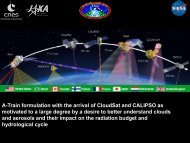Tropical Rainfall Measuring Mission
Tropical Rainfall Measuring Mission
Tropical Rainfall Measuring Mission
You also want an ePaper? Increase the reach of your titles
YUMPU automatically turns print PDFs into web optimized ePapers that Google loves.
TRMM<br />
<strong>Tropical</strong> <strong>Rainfall</strong> <strong>Measuring</strong> <strong>Mission</strong><br />
TRMM Accomplishments After<br />
<strong>Tropical</strong> <strong>Rainfall</strong> <strong>Measuring</strong> <strong>Mission</strong><br />
15 Years<br />
Dr. Scott Braun<br />
TRMM Project Scientist<br />
NASA Goddard Space Flight Center<br />
Water for Life: Symposium on the Role of Space Data<br />
November 12, 2012<br />
G O D D A R D S P A C E F L I G H T C E N T E R 1
TRMM<br />
TRMM Payload<br />
<strong>Tropical</strong> <strong>Rainfall</strong> <strong>Measuring</strong> <strong>Mission</strong><br />
Joint NASA/JAXA mission launched in Nov. 1997<br />
Instrument Payload:<br />
• TRMM Microwave Imager (TMI)— 10, 19, 37, 86 GHz, conical<br />
scanning<br />
• Precipitation Radar (PR) [Japan]— 14 GHz, cross-track scanning<br />
• Lightning Imaging Sensor (LIS)— Staring optical array [MSFC]<br />
• Visible IR Scanner (VIRS)— 5-channel, cross-track scanning<br />
• Clouds and Earth’s Radiant Energy System (CERES)<br />
Hurricane Sandy<br />
on Oct. 28, two<br />
days prior to<br />
landfall<br />
Hurricane Rina (October 26, 2011)<br />
G O D D A R D S P A C E F L I G H T C E N T E R 2
TRMM<br />
Focus Areas<br />
TRMM Science<br />
<strong>Tropical</strong> <strong>Rainfall</strong> <strong>Measuring</strong> <strong>Mission</strong><br />
Accomplishments<br />
Key focus areas:<br />
•Precipitation climatology: Global rainfall, diurnal cycle, latent<br />
heating<br />
•Convective systems research: The University of Utah<br />
Precipitation Feature Database<br />
•Floods: Science and applications<br />
•<strong>Tropical</strong> cyclones: Science and applications<br />
G O D D A R D S P A C E F L I G H T C E N T E R 3
TRMM<br />
TRMM <strong>Rainfall</strong>: Climatology<br />
<strong>Tropical</strong> <strong>Rainfall</strong> <strong>Measuring</strong> <strong>Mission</strong><br />
From<br />
Adler et al.<br />
(2009)<br />
•Benchmark 15 year climatology<br />
•Unique monitoring of<br />
interannual rainfall variations<br />
related to ENSO<br />
•TRMM estimates have become<br />
the standard for improving longterm<br />
climatologies and for<br />
comparison to global climate<br />
models<br />
From Dai (2006)<br />
G O D D A R D S P A C E F L I G H T C E N T E R 4
TRMM<br />
TRMM <strong>Rainfall</strong>: Diurnal Cycle<br />
<strong>Tropical</strong> <strong>Rainfall</strong> <strong>Measuring</strong> <strong>Mission</strong><br />
•Low inclination (35°),<br />
precessing orbit allows sampling<br />
of all local hours over several<br />
weeks<br />
•Quantification of diurnal cycle<br />
of precipitation tropics wide<br />
•Has also allowed focus on<br />
regional and local scales<br />
•Comparison with global climate<br />
models<br />
From Nesbitt and Zipser (2003)<br />
From Dai (2006)<br />
G O D D A R D S P A C E F L I G H T C E N T E R 5
TRMM<br />
TRMM <strong>Rainfall</strong>: Latent Heating Profiles<br />
<strong>Tropical</strong> <strong>Rainfall</strong> <strong>Measuring</strong> <strong>Mission</strong><br />
•Comprehensive estimates of how rainfall<br />
is directly related to latent heat release<br />
(LHR)<br />
•Quantification of LHR related to ENSO,<br />
MJO<br />
•Comparisons to global models<br />
MJO Phase<br />
Phase 1<br />
Phase 2<br />
Phase 3<br />
Phase 4<br />
Phase 5<br />
Phase 6<br />
Phase 7<br />
Phase 8<br />
Courtesy of W.‐K. Tao<br />
From Jiang et al. (2011)<br />
G O D D A R D S P A C E F L I G H T C E N T E R 6
TRMM<br />
The TRMM Precipitation Feature Database<br />
<strong>Tropical</strong> <strong>Rainfall</strong> <strong>Measuring</strong> <strong>Mission</strong><br />
University of Utah: E. Zipser, C. Liu, S. Nesbitt, D. Cecil, H.<br />
Jiang<br />
•TRMM PFD has yielded new insights into<br />
•diurnal cycle of convective systems<br />
•global distribution of convective extremes<br />
•properties of electrified storms<br />
•seasonal are regional distributions of warm rain<br />
•tropical cyclone rainfall properties<br />
Example Precip<br />
Features<br />
G O D D A R D S P A C E F L I G H T C E N T E R 7
TRMM<br />
The TRMM Precipitation Feature Database<br />
<strong>Tropical</strong> <strong>Rainfall</strong> <strong>Measuring</strong> <strong>Mission</strong><br />
•The value of the<br />
TRMM dataset for<br />
climate research<br />
increases with every<br />
year of additional<br />
data<br />
•With 14+ yrs of data,<br />
analyses of regional<br />
seasonal variability<br />
are now becoming<br />
possible<br />
Seasonal variability of precipitation features<br />
in the S.E. United States<br />
Feature size<br />
Month<br />
Feature 30-dBZ echo height<br />
Feature echo top<br />
Feature min. 85-GHz PCT<br />
Seasonal variation of radar (PR) precipitation feature (RPF) characteristics in the<br />
Southeastern U. S. including (a) precipitation feature size, (b) echo top, (c) 30‐dBZ echo<br />
height, and (d) minimum 85‐GHz polarization corrected temperature (PCT).<br />
Courtesy of Chuntao Liu and Ed Zipser.<br />
G O D D A R D S P A C E F L I G H T C E N T E R 8
TRMM<br />
Flood Events: Science<br />
TRMM 3B42 Avg. Rainrate<br />
Understanding Extreme Events Such as the 2010<br />
Pakistan Floods (From Houze et al. 2011)<br />
<strong>Tropical</strong> <strong>Rainfall</strong> <strong>Measuring</strong> <strong>Mission</strong><br />
700 hPa Height anomalies and winds<br />
TPW anomalies and 500 hPa winds<br />
Combining TRMM rainfall and vertical structure<br />
information with environmental information from global<br />
meteorological analyses allows better characterization of<br />
environmental regimes and the role of topography in<br />
extreme orographic events<br />
G O D D A R D S P A C E F L I G H T C E N T E R 9
TRMM<br />
TRMM Multi-Satellite Precipitation Analysis<br />
<strong>Tropical</strong> <strong>Rainfall</strong> <strong>Measuring</strong> <strong>Mission</strong><br />
3-hr window with passive<br />
microwave (gaps filled<br />
with Geo-IR) calibrated<br />
by TRMM<br />
(0.25°<br />
grid)<br />
Research product uses<br />
TRMM radar<br />
information and monthly<br />
gauges--real-time product<br />
avail. ~6 hrs. after obs.<br />
time<br />
9 years+ (‘98-’07)of 3-hr analysis available--produced at TRMM data system.<br />
Available from Goddard DISC (most downloaded TRMM product)<br />
G O D D A R D S P A C E F L I G H T C E N T E R 10
<strong>Tropical</strong> <strong>Rainfall</strong> <strong>Measuring</strong> <strong>Mission</strong><br />
TRMM<br />
Flood Events: Applications<br />
Multi-satellite rainfall estimates converted into<br />
probabilities of flood and landslide occurrence<br />
3-day heavy rains over 250 mm<br />
over Dominican Republic related to<br />
Hurricane Noel produces flooding<br />
(deduced by hydrologic model<br />
running globally in real-time) and<br />
landslides (estimated from real-time<br />
landslide potential algorithm)<br />
<strong>Rainfall</strong> information is from TRMM Multi-satellite Precipitation Analysis (TMPA)<br />
G O D D A R D S P A C E F L I G H T C E N T E R 11
TRMM<br />
TRMM data used by NOAA and DoD (and<br />
int’l agencies) for tropical cyclone detection,<br />
location and intensity estimation<br />
<strong>Tropical</strong> Cyclones: Applications<br />
Hurricane Katrina<br />
<strong>Tropical</strong> <strong>Rainfall</strong> <strong>Measuring</strong> <strong>Mission</strong><br />
~600 TRMM tropical cyclone “fixes” per year<br />
TRMM orbit always in tropics, sampling best<br />
in 10-35º latitude storm band<br />
High horizontal resolution<br />
Precessing orbit provides off-time observations<br />
relative to sun-synchronous satellites<br />
Hurricane Katrina-2005<br />
from TRMM web site<br />
TRMM image<br />
from NRL<br />
<strong>Tropical</strong> Cyclone<br />
web site<br />
TRMM radar (PR) crosssections<br />
of hurricanes<br />
available in real-time for<br />
operational analysis from<br />
TRMM web site<br />
G O D D A R D S P A C E F L I G H T C E N T E R 12
TRMM<br />
<strong>Tropical</strong> Cyclone Science<br />
<strong>Tropical</strong> <strong>Rainfall</strong> <strong>Measuring</strong> <strong>Mission</strong><br />
•<strong>Rainfall</strong> climatologies in<br />
hurricanes<br />
•Radial distribution<br />
•Shear and motion induced<br />
asymmetries<br />
•Eyewall and rainband<br />
vertical structure and<br />
lightning<br />
•Contributions to global<br />
precipitation<br />
•Precipitation feature<br />
database characteristics<br />
•Data assimilation<br />
•Evaluation of storm structures in<br />
mesoscale models<br />
Shear<br />
direction<br />
Normalized <strong>Rainfall</strong> anomaly<br />
From Chen et al. (2006)<br />
•Case studies<br />
•Improved SST estimates in storm<br />
wakes<br />
Courtesy of H. Jiang<br />
G O D D A R D S P A C E F L I G H T C E N T E R 13
TRMM<br />
Summary<br />
<strong>Tropical</strong> <strong>Rainfall</strong> <strong>Measuring</strong> <strong>Mission</strong><br />
• Space standard for measuring<br />
precipitation<br />
• Improved climatology of tropical<br />
rainfall and variations<br />
• Vertical hydrometeor/heating<br />
structure and diurnal signal<br />
• Improved climate and weather<br />
modeling<br />
• Impact of humans on<br />
precipitation<br />
• Hurricane/typhoon<br />
structure/evolution<br />
• Multi-satellite (~3-hr) rainfall<br />
analyses using TRMM+other<br />
satellites<br />
• Flood and agricultural<br />
applications<br />
• Operational use of data by<br />
Estimated Publications by year<br />
>3000 scientific journal<br />
articles published using<br />
TRMM data<br />
G O D D A R D S P A C E F L I G H T C E N T E R 14
TRMM<br />
Current Status<br />
Spacecraft and instrument status:<br />
• All spacecraft systems in excellent shape for continuation<br />
<strong>Tropical</strong> <strong>Rainfall</strong> <strong>Measuring</strong> <strong>Mission</strong><br />
• The Precipitation Radar, Microwave, Visible and IR<br />
Scanner, and Lightning Imaging Sensor (LIS) are all<br />
working well<br />
• Fuel required for<br />
altitude maintenance is<br />
expected to last until<br />
~January 2014<br />
G O D D A R D S P A C E F L I G H T C E N T E R 15


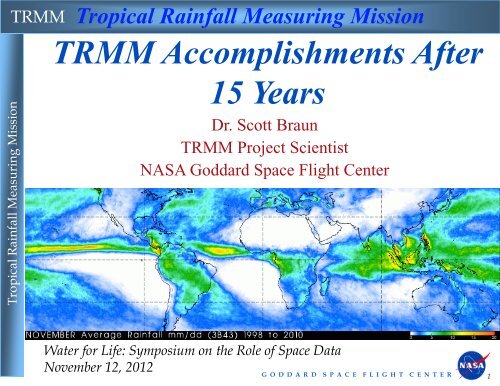
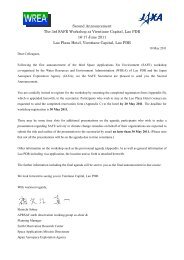
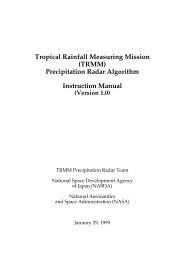


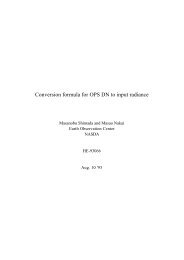
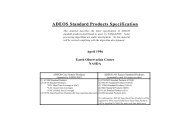
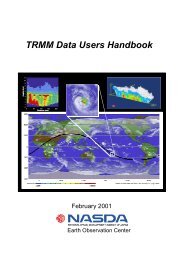
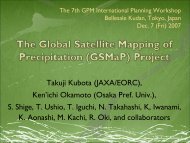
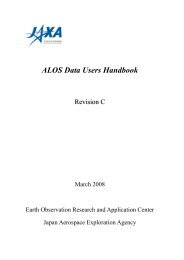
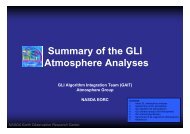
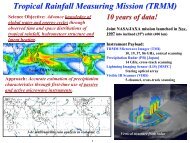
![4.12.2a_Tibet_Wu Guoxiong Tibet-CEOP.ppt[]](https://img.yumpu.com/35802437/1/190x135/4122a-tibet-wu-guoxiong-tibet-ceopppt.jpg?quality=85)
